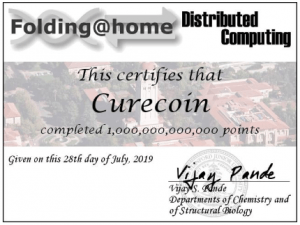Curecoin Team Reaches 1,000,000,000,000 Points on Folding@home
Disclaimer: The text below is a press release that was not written by Cryptonews.com.

__________
Curecoin Team Reaches 1,000,000,000,000 Points on Folding@home…
Curecoin just did the unthinkable – our team has generated 1 Trillion Cumulative Points on Folding@home’s Protein Folding network! Five years ago, naysayers grumbled it would never last, that it would debase the contribution of 100’s of thousands of volunteers, and would only create a system driven by greed. In fact, some of the greatest folders for Curecoin also turned out to be the cryptocurrency world’s most interesting philanthropists – leveraging their CURE to subsidize their electrical power in order to complete MORE “protein folding” simulations to help medical science, AND extend their contributions by donating to our Curecoin Project charities. To date, the Curecoin team has been awarded over 25% of all points on Stanford’s F@H network, even though the network was founded in 2000, and this team started folding in 2014.

What does ONE TRILLION Folding@home Points Accomplish?
Whether you join our team of over 10,000 contributors participating in a broader Folding@home network, OR simply purchase CureCoins – you ARE supporting research! Over 200 scientific papers related to Folding@home are cited in over 3700 related works – part of a broader 34,000 citations outside of the world-wide Folding@home consortium. The works of Pande Labs, led by principal investigators Drs. Vijay Pande and now Greg Bowman, ). We areis helping scientists to accelerate the search for cures in cancers, Alzheimer’s, Huntington’s and infectious disease by simulating up to 12,000 Work Unit (WU)* related protein configurations PER DAY! Notably, the research is increasingly cited in more diverse fields of study beyond medicine. For more information on what protein folding is, its limitations, and how it currently fits into the FDA drug approval process – check out our 2016 Focus on Science article…. Although this cannot be solely attributed to the Curecoin team joining Folding@home in 2014, the average rate of publishing scientific papers by the consortium has increased by 150% (from ~8 per year from 2000 to 2014, to 20 per year since!). See full back links to the research papers and more here.
Thanks to the participation of people like you, the Curecoin Team (in collaboration with Foldingcoin via Merge-Folding) is the strongest team on the most powerful distributed supercomputing network in the world – Folding@home!
Why not just pay for supercomputer time?
Why all the layers of PC’s in Distributed Computing Networks, blockchains, folding clubs, etc.? What are these computations actually worth? This has been a long standing question that we will try to answer as simply as possible. What has made direct funding of protein folding research difficult (using government funds or cash donations), comes from the fact that protein folding research is somewhat exploratory and computationally demanding. Enter a global army of computer enthusiasts, along with AI and Deep Learning techniques – scientists are uncovering new ways to predict protein behaviour in the world’s deadliest diseases.
Even though protein molecules are simulated on computers, they do require a level of “brute force” computation to explore their permutations (or intermediate states). This level of detail would be nearly impossible to produce via physical experimental methods alone. The extensive computational exploration required, combined with uncertain outcomes being a part of the “protein folding problem”, are difficult to justify to government sources of funding, especially while NIH funding is still below 2003 levels adjusted for inflation. It remains a wonder why computational biology (like Folding@home) with computational power being contributed by citizen scientists remains SO underappreciated as a global phenomenon – despite the 19 years of progress.
Cost Savings to Humanity…
We can look at the break-even costs of folding One Trillion Points on Folding@home, not including the value of the discoveries themselves OR the tradable tokens secured by a blockchain that represent the simulation data required for the research. If we compute the average points earned over 5 ½ years of Curecoin (including our beta phase), we’ve nearly 500,000,000 Points-per-Day (PPD) worth of protein folding computations. The Curecoin Team has averaged 4.4 petaFLOPS (native) or 8.8 petaFLOPS (x86) on a continual basis. This is the equivalent of using a quarter (25%) of a $97 million IBM Titan supercomputer which runs nominally at 17.6 petaFLOPS) and using 25% of its 8.2 MW of continuous power since the start of 2014!
1. Running at nominal levels, the Curecoin team’s equivalent computational output would cost the $1.95 per 1 Curecoin using a dedicated partition of a Titan Supercomputer over 5.5 years.
2. Using the same criteria, the Curecoin team’s equivalent computational output would cost $0.68 per token using Amazon AWS EC2 Cloud service over 5.5 years.
Read more about these cost calculations in the full article here.
Folding@home’s brilliant model: By distributing our team’s cost of folding 1 Trillion Points worth of protein folding simulations across a network of over 10,000 individuals and companies using everything from personal laptops and MacBooks, to high-end gaming PCs – all the way to small data centers owned by individuals, Curecoin demonstrates that the cost of contributing to Protein Folding Citizen Science can effectively subsidize all or part of the costs of equipment, electricity and time for those who choose to participate. What makes CURE more cost effective is the utilization of idle personal computers that are already deployed for other tasks (but not all the time). The added benefits of participating with our team on Folding@home creates a global community of individuals who trade their CURE rewards in order to subsidise more computational power, buy from vendors who accept Curecoins, donate to supported charities, or simply trade their tokens in a growing digital currency market.
Read more in the full article here.
{no_ads}
Disclaimer: The text above is an advertorial article that is not part of Cryptonews.com editorial content.


